Kentucky
The first explorers entered Kentucky in the early 1750s, but the French and Indian War brought exploration to a halt. In 1767 Daniel Boone visited the area and in 1769 he returned with a party of hunters for a two year expedition. The first permanent settlement was Fort Harrod, built in 1774 by James Harrod near the site of present day Harrodsburg. Boonesboro followed in 1775, and soon other settlements sprang up. Kentucky was declared part of Virginia in 1776 but pressure for separation built up after the revolution. In 1792 Kentucky began the 15th state. It was a slave state but when the Civil War broke out, opinion was sharply divided so Kentucky took a neutral position. After a pro-Union legislature was elected in 1861 the Confederates invaded and their sympathisers tried to set up a secessionist government. The 1862 Battle of Perryville left Kentucky in Union hands for the rest of the war.
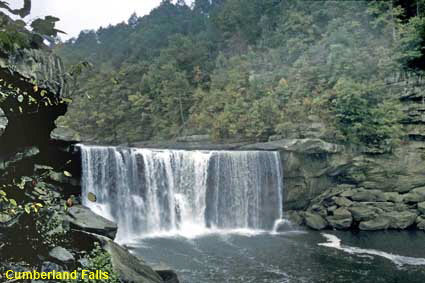
Kentucky Railway Museum, New Haven
We usually plan our visits to preserved railways but this one caught us by surprise. While driving from Lincoln’s Boyhood Home to Lexington we stumbled upon the Kentucky Railway Museum in New Haven. We did not have time to visit the museum, but we stopped for a short time to look round the yard. The museum started in the 1950s with steam locomotive #152 donated by the Louisville and Nashville Railroad. Restoration of the locomotive to working order began in 1972 and was completed in 1985. In the 1990s the museum had to leave its site near Ormsby Village. The museum managed to purchase 27 kilometres (17 miles) of track that was being abandoned and build a new museum on donated land next to the tracks at New Haven.
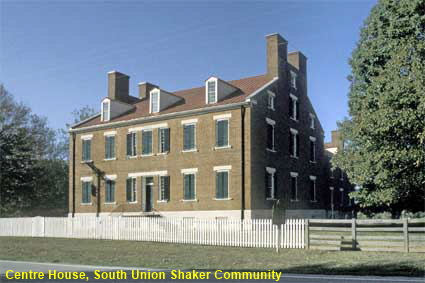
Centre House, South Union Shaker Community
The Shaker movement started in Manchester, (England) in 1747. Officially known as “The United Society of Believers in Christ's Second Appearing” the name Shaker comes from their ecstatic mode of worship. Shakers were celibate and had to recruit all new members from outside. Founded in 1807, the South Union Shaker Community was occupied until 1922. Centre House (yep, the British spelling) was built in 1824. The buildings are now a museum giving an insight into the the Shaker way of life. Shakers manufactured most of their artefacts and both their furniture and their oval boxes are well known and nowadays very fashionable. Click Tab 2 to see the broom making exhibit.
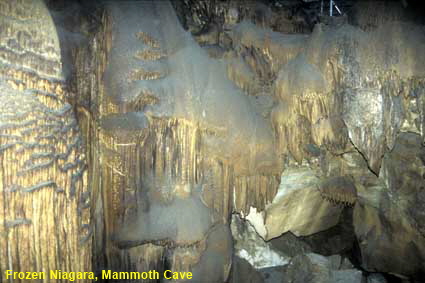
Frozen Niagara, Mammoth Cave
Mammoth Cave is the longest cave system in the world with more than 630 kilometres (390 miles) of caves discovered to date. It is believed that the caves were discovered at the end of the 18th century, and during the War of 1812 the caves were used for mining calcium nitrate for making saltpetre. After the war the price of saltpetre collapsed so in 1816 the caves were opened for tours. The caves are now a National Park, and there is a range of tours that can take you to see different parts of the cave system. Having visited many other cave systems we are not easily impressed, but we were very impressed by the Frozen Niagara formation.
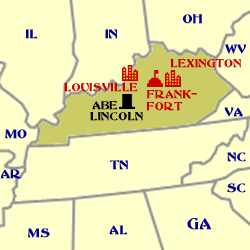
Click on Minimap to navigate
Cumberland Falls
OK, it’s not Niagara (or even Frozen Niagara, see below), but you wouldn’t get to see Niagara Falls in solitude, would you? Hidden in the middle of Daniel Boone State Forest, the 18 metre (60 foot) and 38 metre (125 foot) wide Cumberland Falls form the centrepiece of Cumberland Falls State Park. Despite being somewhat smaller the falls are often called ‘the Niagara of the South’. The park no doubt attracts plenty of visitors in the season, but when we were there in October 1999 it was very quiet. Cumberland Falls are known for their ‘moonbow’, which can be seen over the falls on clear nights during a full moon.
Kentucky State Capitol, Frankfort
When Kentucky gained statehood, Frankfort was made the capital. In 1904 the third capitol building had become too small and the General Assembly considered moving the capital to Lexington or Louisville, but voted to stay in Frankfort. Work began on the new capitol in 1905 to a design by Ohio architect Frank Andrews. Although the capitol has the look of a ‘classic’ US capitol building, Andrews was influenced by the style of large buildings and palaces in France. Unlike many state capitols, money was not a problem as Kentucky was able to use federal funds from claims for Civil War damage and for services rendered during the Spanish-American War. The resulting building is impressive with its huge ionic columns each weighing 18 tonnes. The capitol opened for business in 1910.
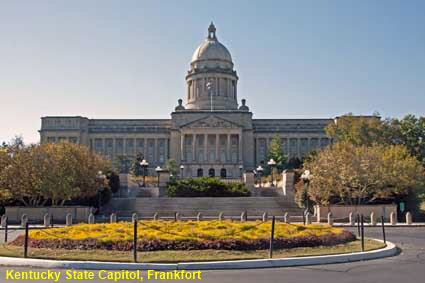
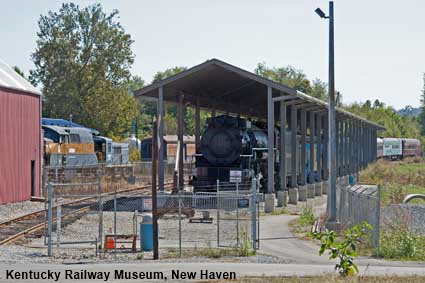
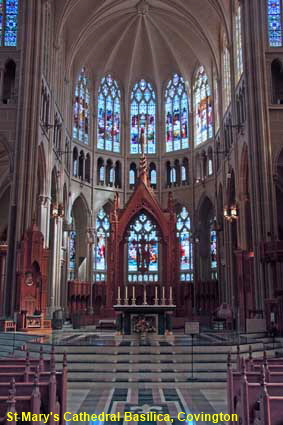
St Mary's Cathedral Basilica, Covington
Covington sits on the Kentucky side of the Ohio River just opposite Cincinnati, Ohio. Here stands one of only 35 basilicas in the USA. The first St. Mary’s Church was dedicated in 1834, but by 1851 growth in the population of Covington had made it too small. Work on a cathedral for the newly created diocese of Covington began in 1853 but by 1868 the congregation had again outgrown the cathedral. It was not until 1890 that a site was acquired for a new cathedral and construction began in 1894. The Gothic cathedral was designed by Leon Coquard, who had designed other ecclesiastical buildings. When work finished in 1915, the exterior was incomplete and it remains so to this day. Pope Pius XII made the cathedral a Minor Basilica in 1953. The interior of St Mary's Cathedral Basilica is exceptional, with some wonderful stained glass windows that make it very light and airy. Click Tab 2 to see the exterior of the Cathedral.


We have more pages on Kentucky. Click below or on the Minimap:
DLU110311

© Mike Elsden 1981 - 2025
The contents of this page may not be reproduced in full or in part without permission